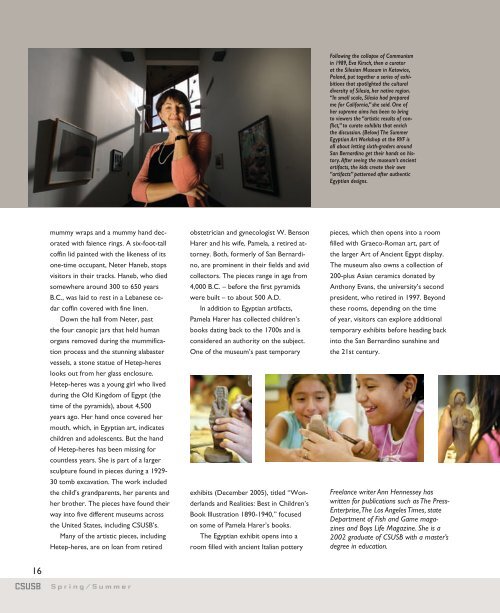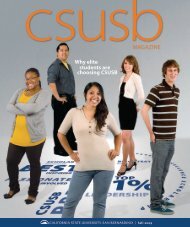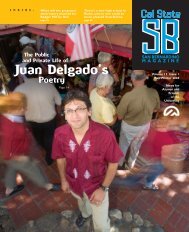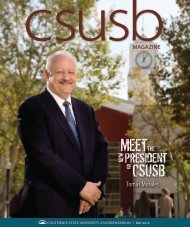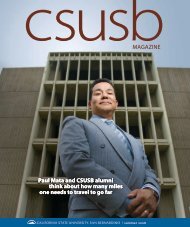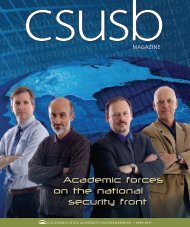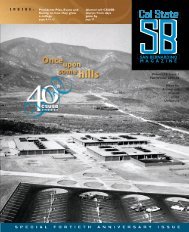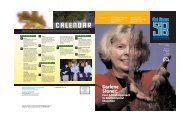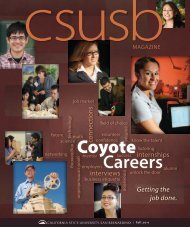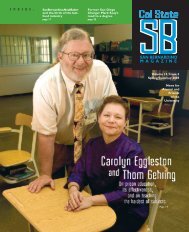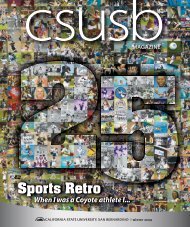Insights into the Ancient, the Contemporary Insights into the Ancient ...
Insights into the Ancient, the Contemporary Insights into the Ancient ...
Insights into the Ancient, the Contemporary Insights into the Ancient ...
You also want an ePaper? Increase the reach of your titles
YUMPU automatically turns print PDFs into web optimized ePapers that Google loves.
16<br />
CSUSB<br />
mummy wraps and a mummy hand decorated<br />
with faience rings. A six-foot-tall<br />
coffin lid painted with <strong>the</strong> likeness of its<br />
one-time occupant, Neter Haneb, stops<br />
visitors in <strong>the</strong>ir tracks. Haneb, who died<br />
somewhere around 300 to 650 years<br />
B.C., was laid to rest in a Lebanese cedar<br />
coffin covered with fine linen.<br />
Down <strong>the</strong> hall from Neter, past<br />
<strong>the</strong> four canopic jars that held human<br />
organs removed during <strong>the</strong> mummification<br />
process and <strong>the</strong> stunning alabaster<br />
vessels, a stone statue of Hetep-heres<br />
looks out from her glass enclosure.<br />
Hetep-heres was a young girl who lived<br />
during <strong>the</strong> Old Kingdom of Egypt (<strong>the</strong><br />
time of <strong>the</strong> pyramids), about 4,500<br />
years ago. Her hand once covered her<br />
mouth, which, in Egyptian art, indicates<br />
children and adolescents. But <strong>the</strong> hand<br />
of Hetep-heres has been missing for<br />
countless years. She is part of a larger<br />
sculpture found in pieces during a 1929-<br />
30 tomb excavation. The work included<br />
<strong>the</strong> child’s grandparents, her parents and<br />
her bro<strong>the</strong>r. The pieces have found <strong>the</strong>ir<br />
way <strong>into</strong> five different museums across<br />
<strong>the</strong> United States, including CSUSB’s.<br />
Many of <strong>the</strong> artistic pieces, including<br />
Hetep-heres, are on loan from retired<br />
Spring/Summer<br />
obstetrician and gynecologist W. Benson<br />
Harer and his wife, Pamela, a retired attorney.<br />
Both, formerly of San Bernardino,<br />
are prominent in <strong>the</strong>ir fields and avid<br />
collectors. The pieces range in age from<br />
4,000 B.C. – before <strong>the</strong> first pyramids<br />
were built – to about 500 A.D.<br />
In addition to Egyptian artifacts,<br />
Pamela Harer has collected children’s<br />
books dating back to <strong>the</strong> 1700s and is<br />
considered an authority on <strong>the</strong> subject.<br />
One of <strong>the</strong> museum’s past temporary<br />
exhibits (December 2005), titled “Wonderlands<br />
and Realities: Best in Children’s<br />
Book Illustration 1890-1940,” focused<br />
on some of Pamela Harer’s books.<br />
The Egyptian exhibit opens <strong>into</strong> a<br />
room filled with ancient Italian pottery<br />
Following <strong>the</strong> collapse of Communism<br />
in 1989, Eva Kirsch, <strong>the</strong>n a curator<br />
at <strong>the</strong> Silesian Museum in Katowice,<br />
Poland, put toge<strong>the</strong>r a series of exhibitions<br />
that spotlighted <strong>the</strong> cultural<br />
diversity of Silesia, her native region.<br />
“In small scale, Silesia had prepared<br />
me for California,” she said. One of<br />
her supreme aims has been to bring<br />
to viewers <strong>the</strong> “artistic results of conflict,”<br />
to curate exhibits that enrich<br />
<strong>the</strong> discussion. (Below) The Summer<br />
Egyptian Art Workshop at <strong>the</strong> RVF is<br />
all about letting sixth-graders around<br />
San Bernardino get <strong>the</strong>ir hands on history.<br />
After seeing <strong>the</strong> museum’s ancient<br />
artifacts, <strong>the</strong> kids create <strong>the</strong>ir own<br />
“artifacts” patterned after au<strong>the</strong>ntic<br />
Egyptian designs.<br />
pieces, which <strong>the</strong>n opens <strong>into</strong> a room<br />
filled with Graeco-Roman art, part of<br />
<strong>the</strong> larger Art of <strong>Ancient</strong> Egypt display.<br />
The museum also owns a collection of<br />
200-plus Asian ceramics donated by<br />
Anthony Evans, <strong>the</strong> university’s second<br />
president, who retired in 1997. Beyond<br />
<strong>the</strong>se rooms, depending on <strong>the</strong> time<br />
of year, visitors can explore additional<br />
temporary exhibits before heading back<br />
<strong>into</strong> <strong>the</strong> San Bernardino sunshine and<br />
<strong>the</strong> 21st century.<br />
Freelance writer Ann Hennessey has<br />
written for publications such as The Press-<br />
Enterprise, The Los Angeles Times, state<br />
Department of Fish and Game magazines<br />
and Boys Life Magazine. She is a<br />
2002 graduate of CSUSB with a master’s<br />
degree in education.


